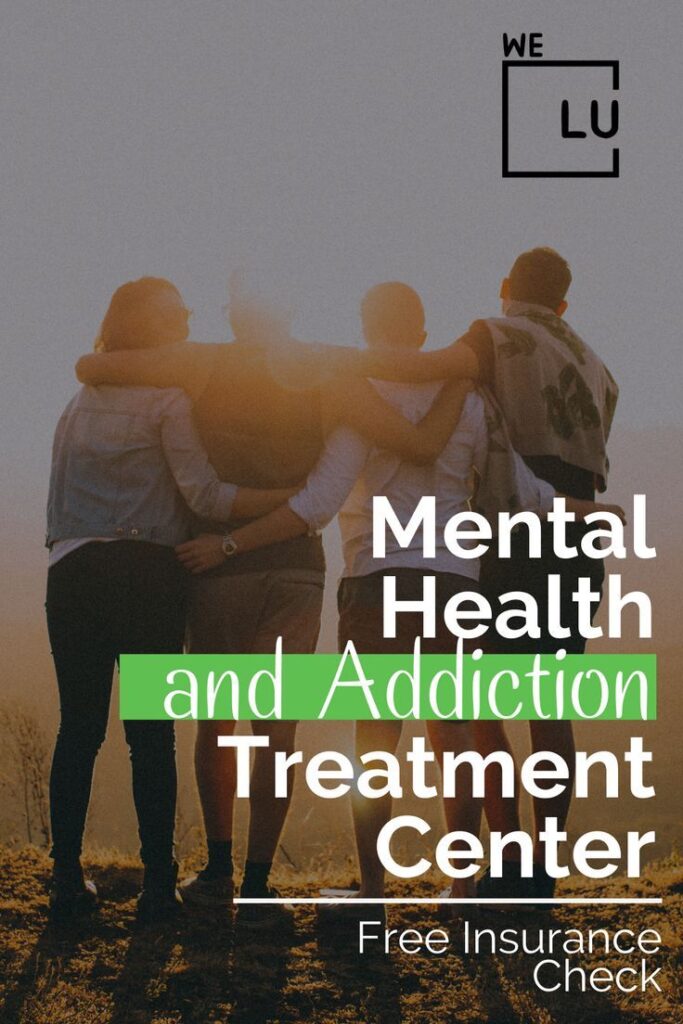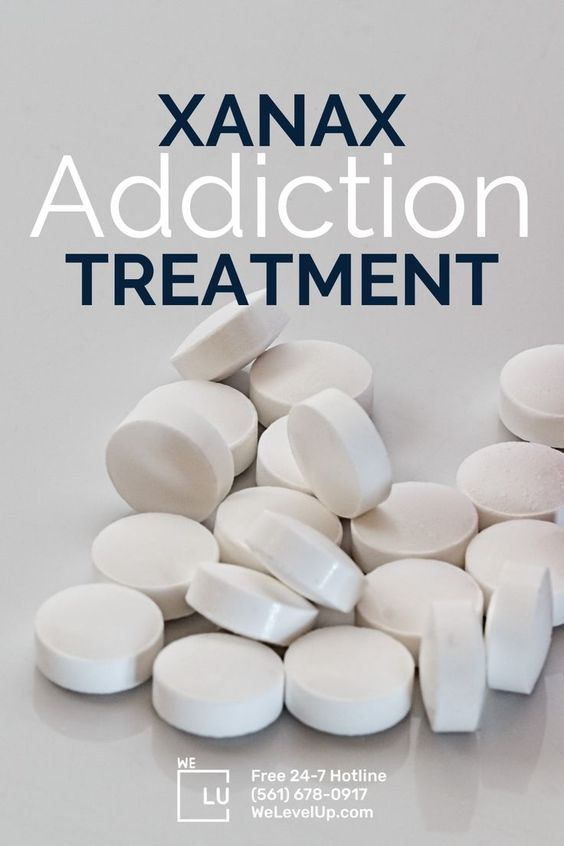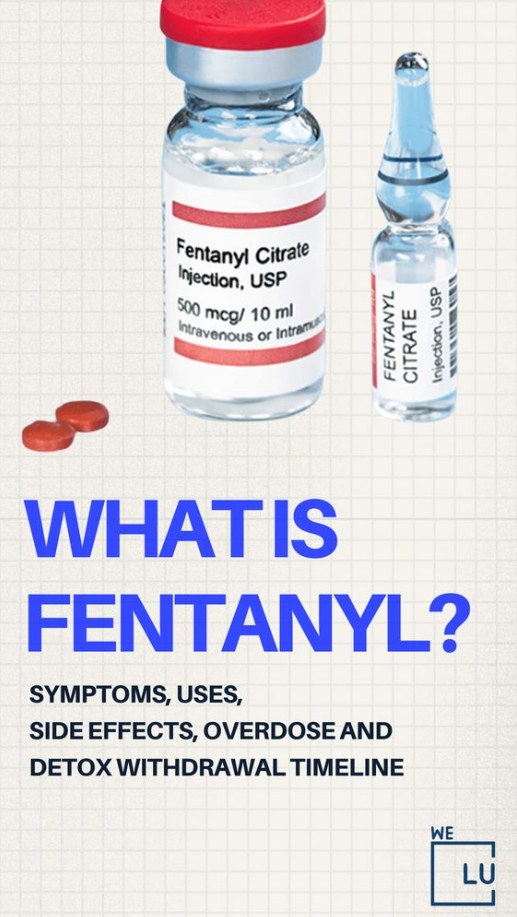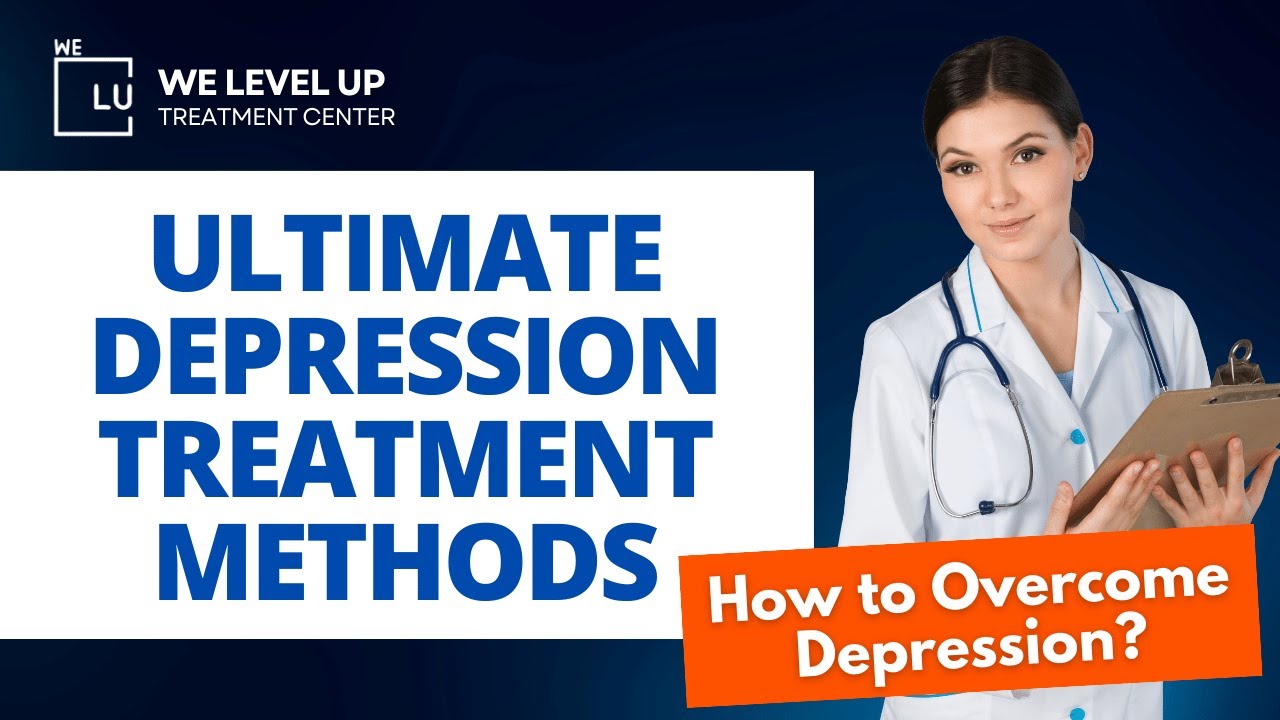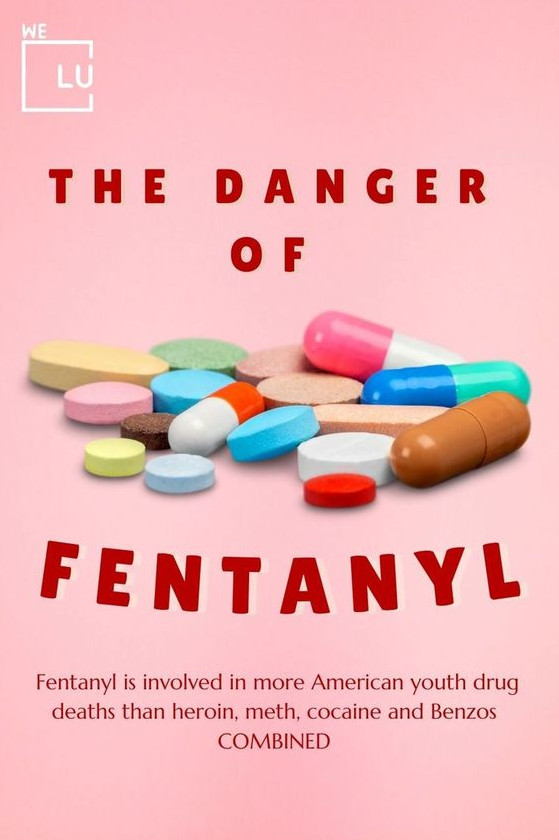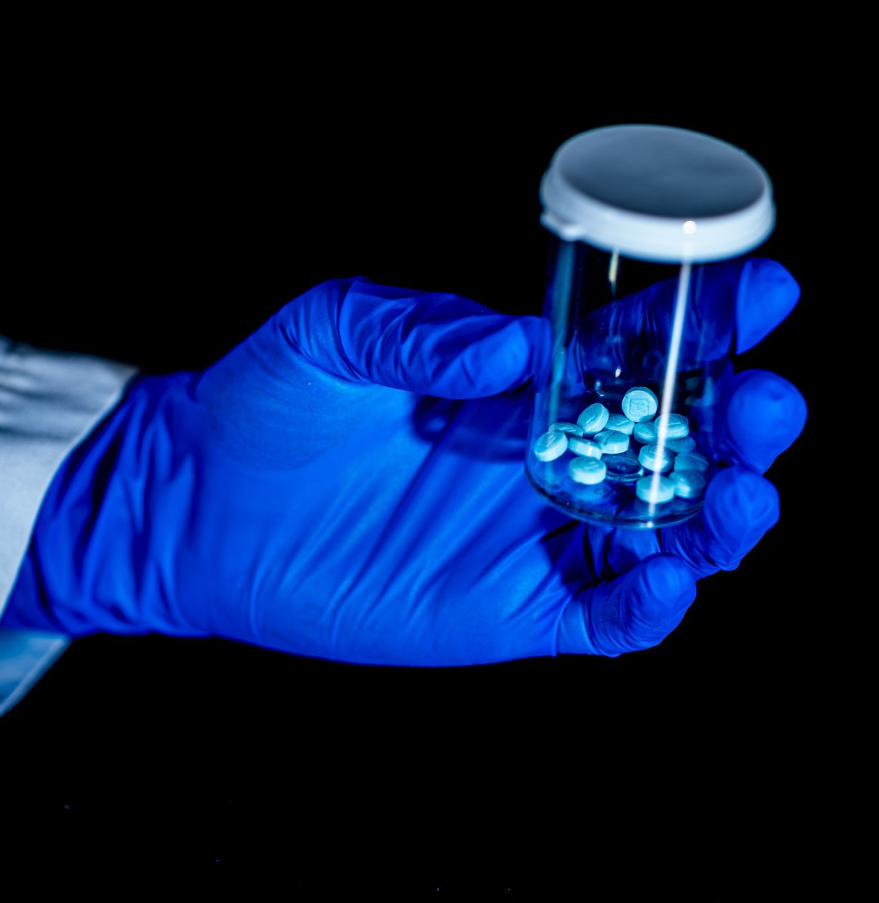Suboxone detox program makes the journey to a drug-free life more manageable, preventing the discomfort of abrupt withdrawal symptoms.
Prescription opiate users frequently switch to illegal heroin, which increases the chance of overdose. Overuse of opioids has a negative influence on the community as a whole and overcrowds hospitals and treatment facilities with people with addiction. One medicine used to treat this problem is Suboxone, which reduces cravings for opioids and prevents relapses. However, Suboxone dependency and abuse are regrettably possible outcomes as well.
Many people may not fully understand the problems associated with using Suboxone, and the severity of withdrawal symptoms from Suboxone is often underestimated.
Detoxing off Suboxone involves gradually reducing the dosage under medical supervision. Get facts about Suboxone detox at We Level Up Texas treatment center. Make this your opportunity to reclaim your life. Call We Level Up TX 24/7 for a free consultation. Every call is free and confidential.
What is Suboxone?
Suboxone is a prescription that has the combination of naloxone and buprenorphine to treat opiate dependency.
The prescription medication Suboxone, which binds to the same brain receptors as opioids, reduces cravings and the symptoms of withdrawal from opioids. Though designed for addiction rehabilitation, some users misuse it for a brief period.
Abusers of illegally acquired Suboxone, also known as “subs,” may crush and inject the medication, which is available as pills or dissolvable strips. When heroin isn’t available, many people who abuse Suboxone utilize it to escape withdrawal rather than receiving treatment. Certain people who receive legal prescriptions might develop addictions through unethical tactics like doctor shopping. Moreover, individuals who lack an opiate tolerance may use Suboxone to get high, putting them at risk for addiction and a possible jump to heroin or harsher opioids.
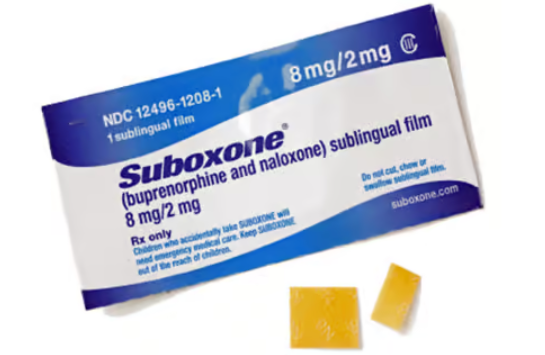
Suboxone Withdrawal Symptoms
Suboxone is often taken for lengthy periods following the cessation of other addictive opioids, and it may be a beneficial medicine in the treatment of opiate dependency. Although Suboxone is a valuable drug, it has the potential to become addictive. If Suboxone is stopped “cold turkey,” its partial opioid agonist withdrawal symptoms are comparable to those of other opioids.
Suboxone withdrawal symptoms can persist for up to a month and may include:
- Anxiety.
- Insomnia.
- Sweating.
- Nausea.
- Vomiting.
- Diarrhea.
- Abdominal pain.
- Muscle aches.
- Runny nose.
- Dilated pupils.
- Goosebumps.
- Fatigue.
- Irritability.
- Depression.
- Drug cravings.
The symptoms’ length and intensity might differ according to the dosage and length of time that individuals have been taking Suboxone.
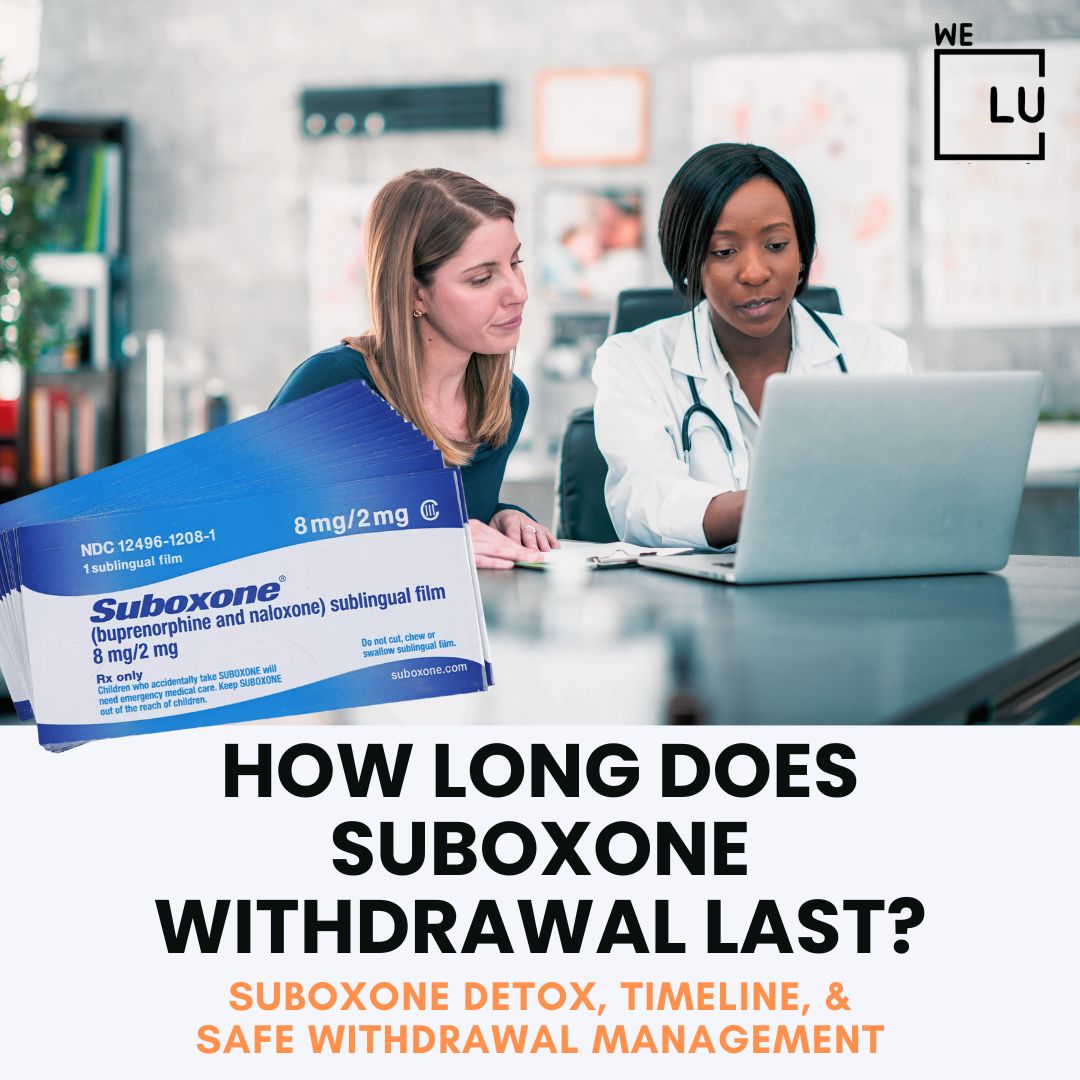
Skip To:
Learn More:
How Long Does Suboxone Withdrawal Last?
While psychological dependency may remain, physical symptoms of Suboxone withdrawal often subside within a month. Intense physical symptoms characterize the first 72 hours, which are the most challenging. General pain, sleeplessness, and mood changes become more prevalent during the first week. This is a crucial phase where relapse risk is high since depression becomes apparent in the second week and continues to be accompanied by melancholy and cravings even after a month. A successful and long-lasting recovery path depends on acknowledging the sensitive nature of this post-withdrawal stage.
Suboxone Withdrawal Timeline Chart
The length and amount of Suboxone use might affect the withdrawal symptoms. Usually, after a month, the physical symptoms go away, but psychological withdrawal could still exist. The first 72 hours of physical symptoms are the worst.
While general discomfort is the predominant symptom in the first week, depression starts to show during the second week. A substantial probability of relapse is present if depressive symptoms and intense cravings persist after a month. If you’re addicted to Suboxone, get expert assistance. Although significant physical symptoms subside within a month, psychological effects may last for many months, underscoring the necessity of continuous assistance.
| Day/Week | Physical Symptoms | Psychological Symptoms | Risk/Notes |
|---|---|---|---|
| 1-3 | Intense physical symptoms (nausea and vomiting) | Heightened anxiety, insomnia | High risk of relapse |
| 4-7 | Transition to general discomfort | Insomnia persists, mood swings | Continued support is crucial |
| 8-14 | Depression becomes prominent | Ongoing support and aftercare are crucial | Monitor closely |
| Week 3-4 | Intense cravings, persistent depression | High risk of relapse | Critical phase |
| Beyond Week 4 | Gradual improvement in symptoms | Psychological dependence may persist | Ongoing support and aftercare crucial |
If you’re detoxing from Suboxone, get treatment counseling that works. Discover professional help from We Level Up Texas’ addiction and mental health therapists. Start getting support with a free call to our addiction hotline.
How Long Does It Take To Detox From Suboxone?
The withdrawal symptoms associated with quitting Suboxone use can be managed with the use of a medical detox program. Medical detox treatments typically consist of five to seven days and include 24-hour medical supervision in a supervised setting. In an inpatient environment, ongoing therapy and relapse prevention programs following detoxification might take up to thirty days.
To achieve complete recovery, Suboxone use will gradually be tapered down. This procedure should be carried out slowly and methodically to account for the person’s experience and stability. It is vital to design a new course for rehabilitation that could not involve taking any form of opioid medicine when Suboxone turns into an addiction, as well as if the patient no longer benefits from using the drug.
Get Help. Get Better. Get Your Life Back.
Searching for Accredited Drug and Alcohol Rehab Centers Near You? We Level Up Texas Is Opening Soon!
Even if you have failed previously and relapsed, or are in the middle of a difficult crisis, we stand ready to support you. Our trusted behavioral health specialists will not give up on you. When you feel ready or just want someone to speak to about therapy alternatives to change your life call us. Even if we cannot assist you, we will lead you to wherever you can get support. There is no obligation. Call our network hotline today.
FREE Addiction Hotline – Call 24/7How To Detox From Suboxone?
Suboxone detoxification needs to be carried out under a doctor’s supervision. To minimize withdrawal symptoms, a progressive tapering technique is sometimes used, in which the dose is gradually lowered. Safe and comfortable management of the detoxification process is facilitated by medical supervision. To address the psychological and physical components of detoxification and prepare the path for a successful recovery, supportive treatments, along with counseling, are frequently combined.
Suboxone Detox Process
Detoxing from Suboxone under medical guidance can be summarized in the following:
- Medical supervision.
- Gradual tapering of dosage.
- Monitoring and management of withdrawal symptoms.
- Supportive therapies and counseling.
Medical Supervision
The partial opioid agonist buprenorphine, which is a component of Suboxone, works on the same brain receptors as other opioids but has a softer impact. To adjust the dosage, reduce any adverse effects, and assist patients in developing a stable and regulated response to Suboxone, monitoring is crucial when tapering down Suboxone. This improves the treatment’s overall efficacy.
Gradual Tapering of Suboxone Dosage
Tapering the dose of Suboxone gradually lowers the prescribed quantity while following physician advice. With this method, withdrawal symptoms are reduced, and people can adjust slowly, facilitating a more seamless transition to eventual cessation.
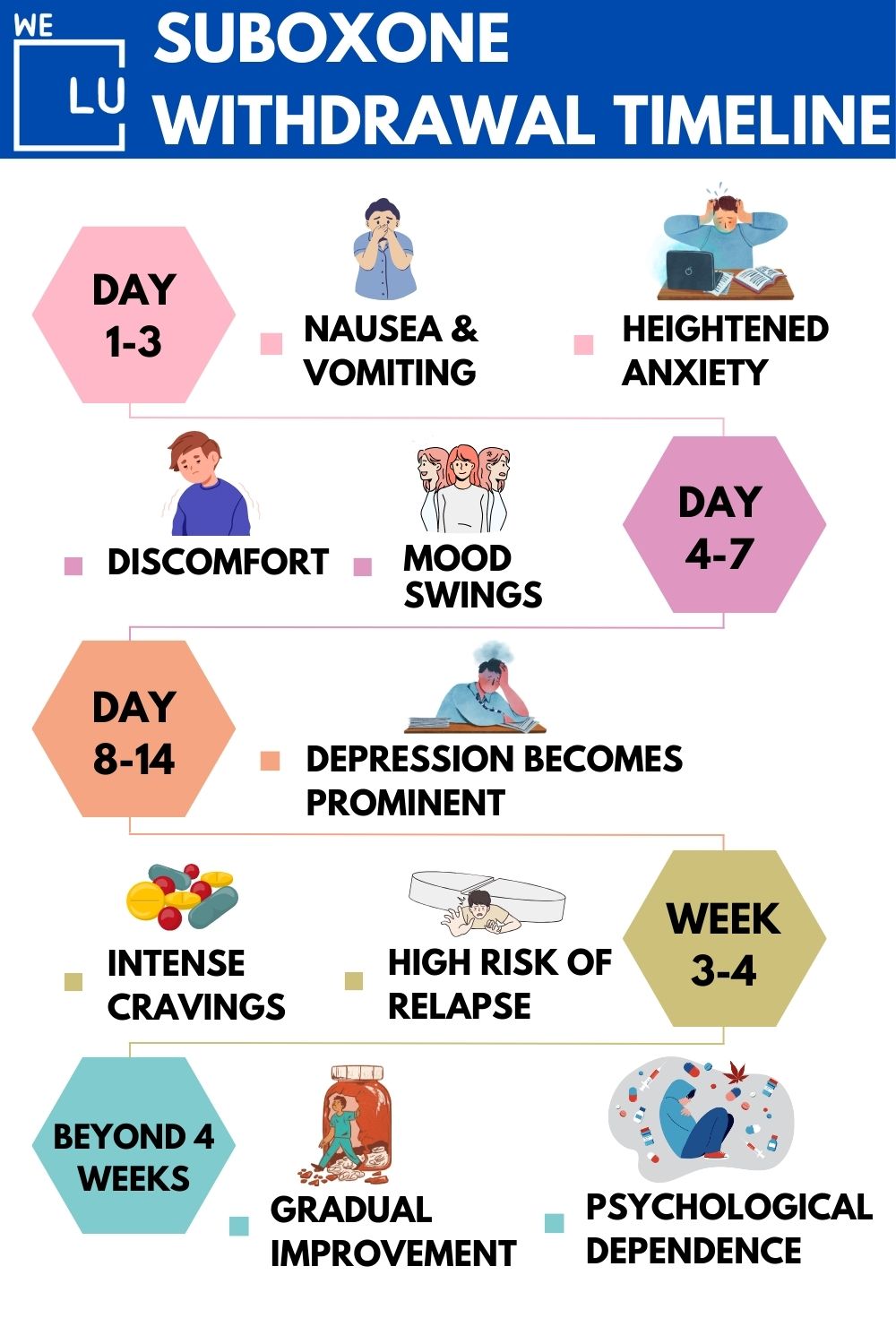
Monitoring and Management of Withdrawal Symptoms
Suboxone withdrawal monitoring and management entails evaluating psychological and physical symptoms and modifying medication as necessary. Experts in detox treatment guarantee a well-rounded and encouraging approach that facilitates healing.
Supportive Therapies and Counseling
Taking a step towards a drug-free life involves a holistic approach. Supportive and evidence-based therapies and counseling are vital, offering a foundation for lasting recovery. Here are the most beneficial treatments you can get in an inpatient Suboxone detox:
- Cognitive-behavioral therapy.
- Mindfulness practices.
- Individual counseling.
- Group therapy.
- Art therapy.
- Holistic wellness.
- Life skills training.
- Peer support.
- Stress management.
- Relapse prevention techniques.
To assist people in safely stopping using Suboxone, a carefully monitored detox process is employed. The dose of Suboxone is gradually tapered off under the guidance of medical specialists to reduce the severity of withdrawal symptoms. During the detoxification process, patients may expect a more pleasant and regulated environment since medical personnel constantly monitor and handle any physical or psychological pain that may arise. Supportive treatments and counseling are also frequently incorporated into detox programs to meet the holistic needs of the participants, facilitate a more seamless transition, and establish the foundation for long-term recovery.
Warnings About Rapid Suboxone Detox
To hasten the withdrawal process, rapid Suboxone detox is not advised since it has several hazards. The risk of consequences increases when there is an abrupt stop because of the potential for significant withdrawal symptoms, both physically and mentally. Using this method might make cravings worse and endanger the person’s health. An efficient and safe Suboxone detox depends on expert supervision, which guarantees a progressive tapering schedule that reduces discomfort and aids the patient in their recovery. Inadequate monitoring during a quick detox might be harmful to one’s physical well-being and reduce the likelihood of a long-term recovery.
If you’re seeking assistance with your rehab journey, reach out to a We Level Up Texas treatment professional today—your call is free and confidential.
Opening Soon! First-Class Facilities & Amenities
World-Class High-Quality Addiction & Mental Health Rehabilitation Treatment
Coming Soon! Rehab Centers TourRenowned Addiction Centers. Serene Private Facilities. Inpatient Rehab Programs Vary.
FREE Addiction Hotline – Call 24/7Proven recovery success experience, backed by a Team with History of:
- 15+ Years Experience
- 100s of 5-Star Reviews
- 10K+ Recovery Successes
- Low Patient to Therapist Ratio
- Onsite Medical Detox Center
- Comprehensive Dual-Diagnosis Treatment
- Complimentary Family & Alumni Programs
- Coaching, Recovery & Personal Development Events
Is Suboxone Addictive?
Addiction to Suboxone is possible. Primarily composed of buprenorphine, a partial opioid agonist with the potential for addiction, it also contains naloxone, an opioid antagonist that discourages abuse by injection. Suboxone alleviates opioid dependency when used as directed; nevertheless, abuse or sudden cessation of the medication can result in addiction and withdrawal symptoms. For Suboxone to balance its therapeutic advantages and reduce the danger of addiction, it must be used under medical supervision and by recommended instructions.
Managing Opioid Addiction Without Medication
If medication-assisted therapy—such as methadone and Suboxone—is not available, a comprehensive and personalized approach is required to treat opioid addiction safely. Counseling, support groups, and behavioral therapy are crucial forms of treatment for the psychological aspects of addiction. Individuals who want to modify the behavioral patterns that lead to their addiction can effectively identify and assist with behavioral therapy.
The most effective therapies for Suboxone addiction include:
- Cognitive-behavioral therapy (CBT).
- Motivational enhancement therapy.
- Contingency management.
- Support groups.
- Family therapy.
- Holistic interventions.
- Dialectical behavior therapy (DBT).
- Trauma-focused therapies.
- Mindfulness-based therapies.
- 12-step programs.
While medication-assisted treatment is beneficial for many, alternative approaches focus on empowering individuals to overcome addiction through behavioral changes, emotional support, and building a solid foundation for a drug-free life.
Suboxone Detox Infographic
The infographic below focuses on Suboxone, a medication used to treat opioid overuse. Suboxone helps reduce cravings for opioids and prevents relapses. Despite its effectiveness, there is a risk of developing dependency and abusing Suboxone.
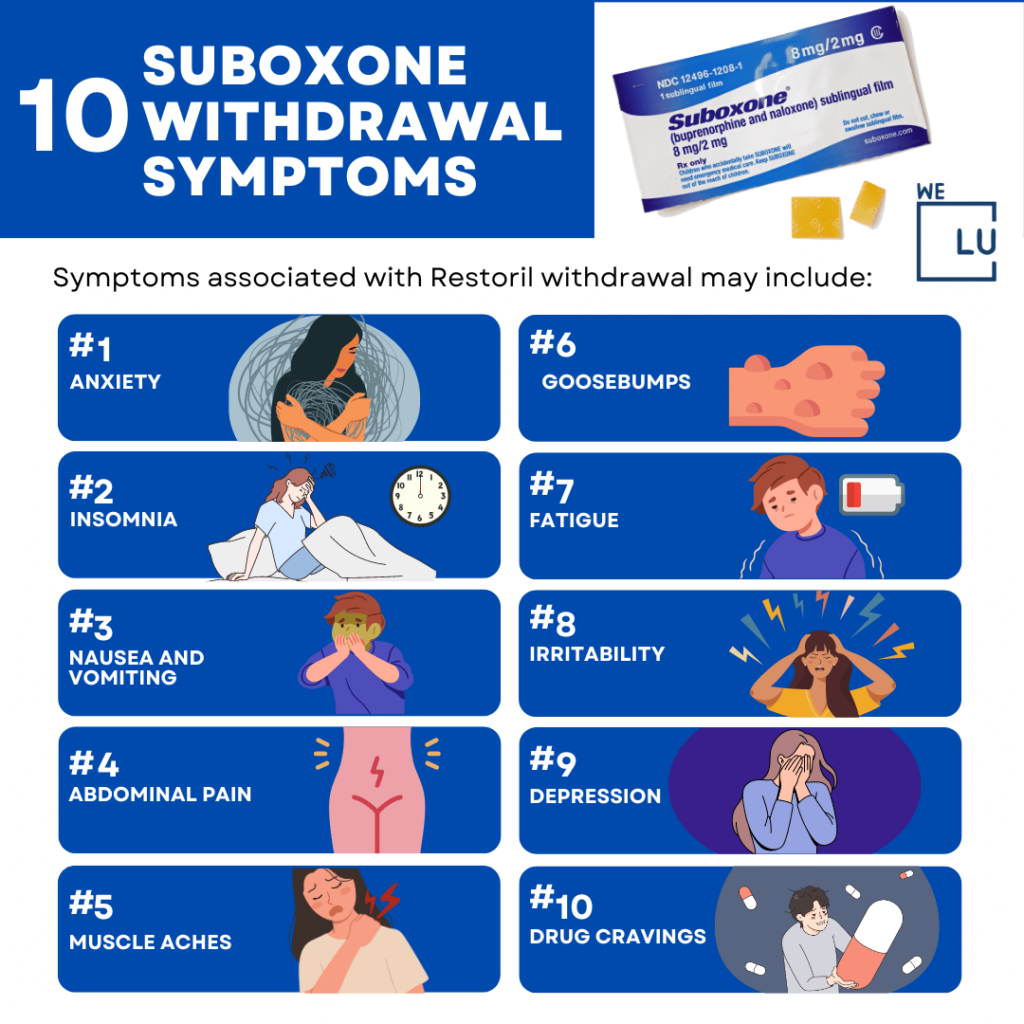
Embed the below “10 Suboxone Withdrawal Symptoms” Infographic to your Website. This infographic is provided by the We Level Up Addiction Treatment Center team. To use the below infographics, you agree to link back and attribute its source and owner at https://weleveluptx.com/suboxone-detox/
10 Suboxone Withdrawal Symptoms Infographic image link: https://weleveluptx.com/wp-content/uploads/2024/03/10-Suboxone-Withdrawal-Symptoms-How-Long-Does-Suboxone-Withdrawal-Last-Is-Suboxone-Addictive-Suboxone-Addiction-Treatment-1024×1024.png
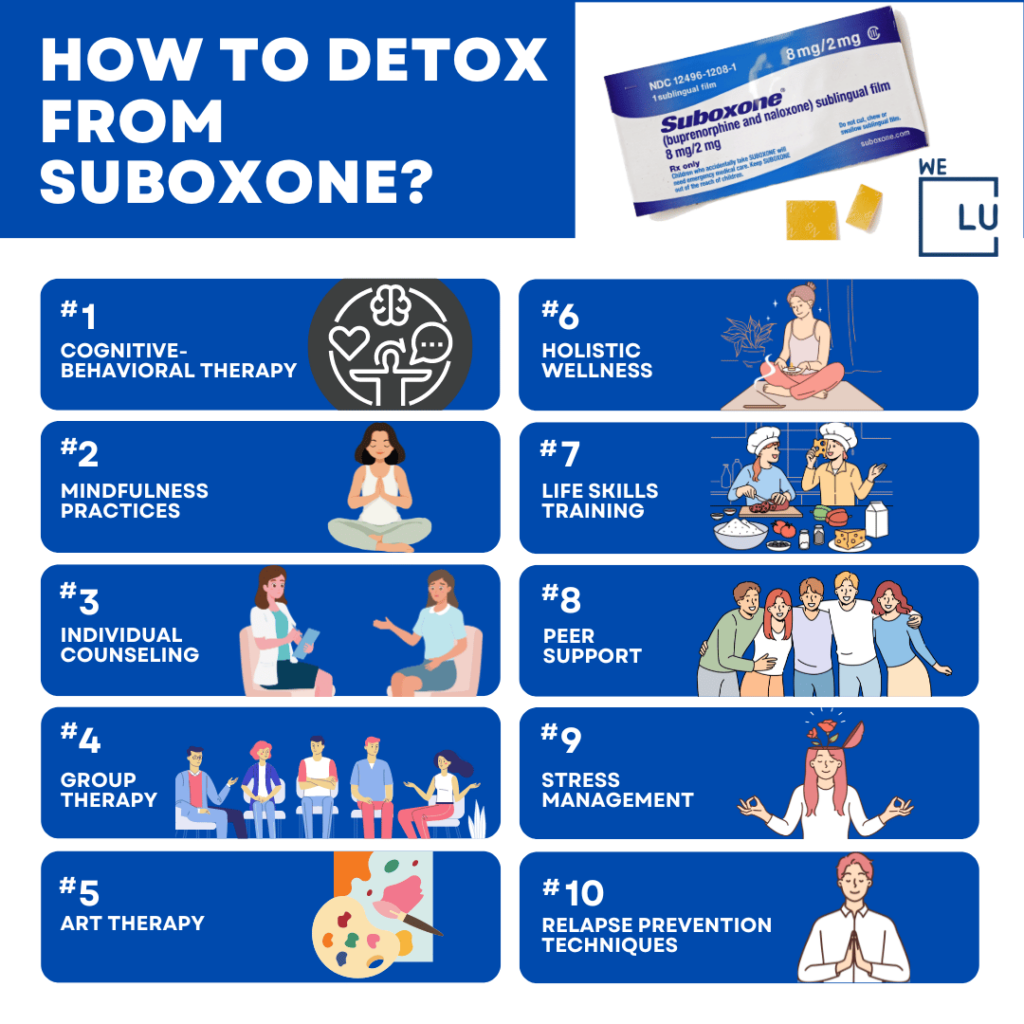
Embed the below “How To Detox From Suboxone” Infographic to your Website. This infographic is provided by the We Level Up Addiction Treatment Center team. To use the below infographics, you agree to link back and attribute its source and owner at https://weleveluptx.com/suboxone-detox/
How To Detox From Suboxone Infographic image link: https://weleveluptx.com/wp-content/uploads/2024/03/10-Suboxone-Withdrawal-Symptoms-How-Long-Does-Suboxone-Withdrawal-Last-Is-Suboxone-Addictive-Suboxone-Addiction-Treatment-1024×1024.png
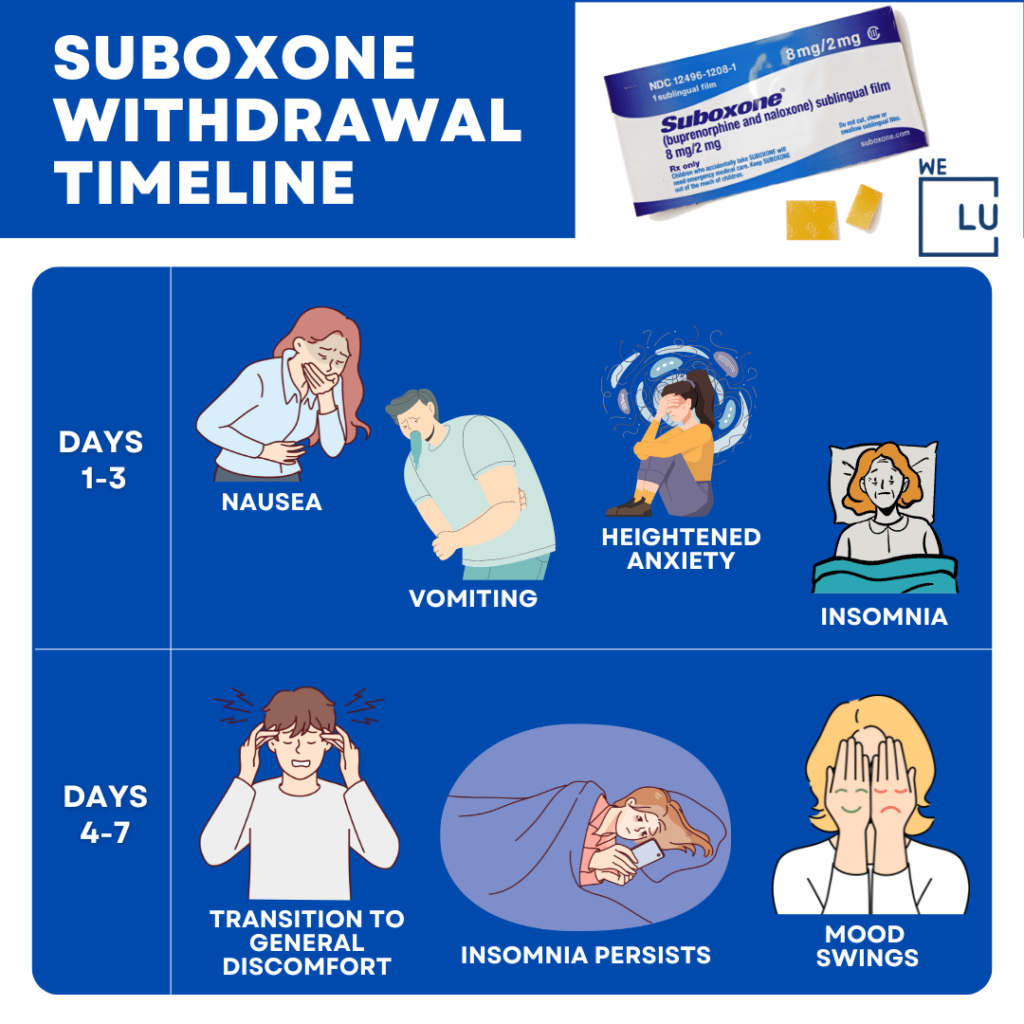
Embed the below “Suboxone Withdrawal Timeline 1” Infographic to your Website. This infographic is provided by the We Level Up Addiction Treatment Center team. To use the below infographics, you agree to link back and attribute its source and owner at https://weleveluptx.com/suboxone-detox/
Suboxone Withdrawal Timeline 1 Infographic image link: https://weleveluptx.com/wp-content/uploads/2024/03/Suboxone-Withdrawal-Timeline-1-Suboxone-Withdrawal-Symptoms-How-Long-Does-Suboxone-Withdrawal-Last-Is-Suboxone-Addictive-Suboxone-Addiction-Treatment-1024×1024.png
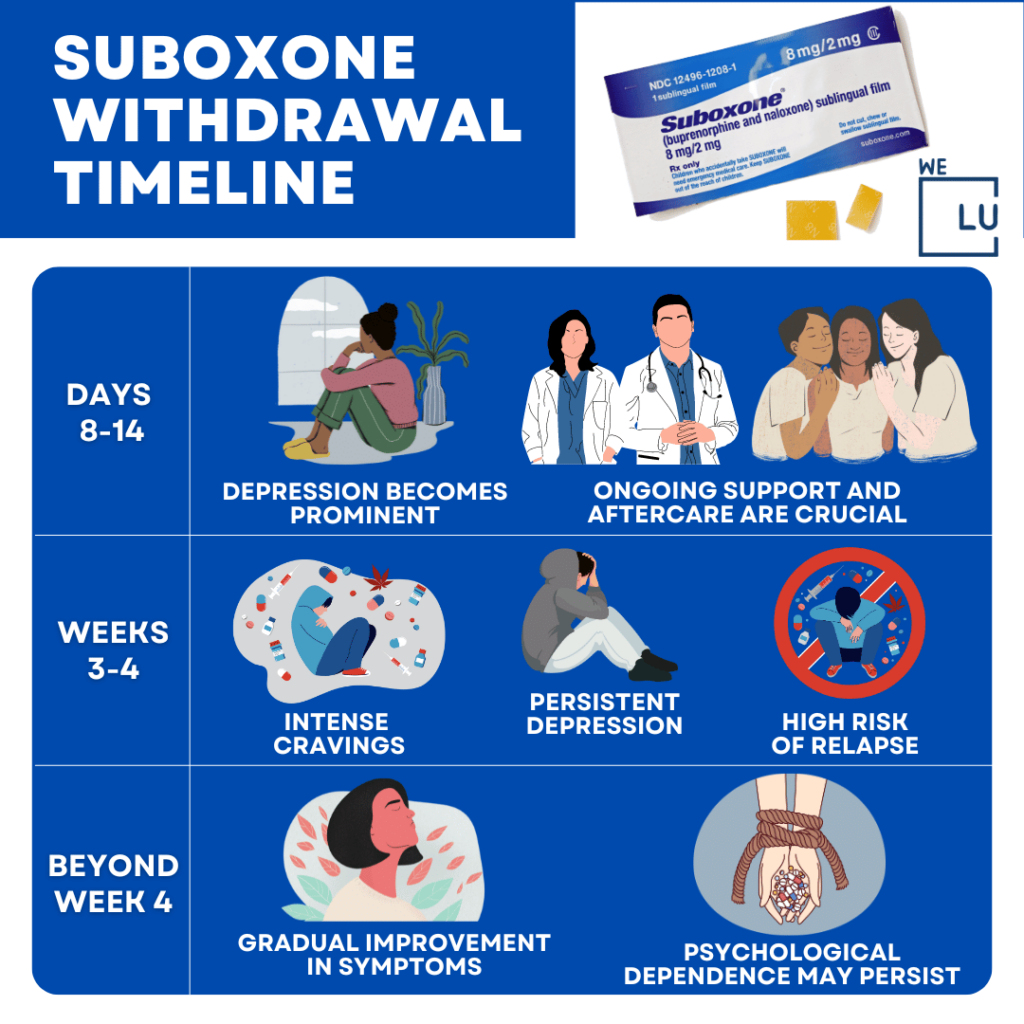
Embed the below “Suboxone Withdrawal Timeline 2” Infographic to your Website. This infographic is provided by the We Level Up Addiction Treatment Center team. To use the below infographics, you agree to link back and attribute its source and owner at https://weleveluptx.com/suboxone-detox/
Suboxone Withdrawal Timeline 2 Infographic image link: https://weleveluptx.com/wp-content/uploads/2024/03/Suboxone-Withdrawal-Timeline-2-Suboxone-Withdrawal-Symptoms-How-Long-Does-Suboxone-Withdrawal-Last-Is-Suboxone-Addictive-Suboxone-Addiction-Treatment-1024×1024.png
Suboxone Addiction Treatment
Because of the many ways that inpatient therapy helps to create a more regulated and encouraging atmosphere, it is highly advised for Suboxone addiction. Relapse during the early phases of rehabilitation is less likely in the controlled setting because it limits external stimuli and distractions.
Further guaranteeing a secure and efficient detoxification procedure and handling any difficulties or withdrawal symptoms is the availability of medical monitoring around the clock.
Suboxone can be tapered slowly and under medical supervision in an organized inpatient environment, which makes the withdrawal process more accessible to handle and more gradual. To provide people with a greater degree of care and support while they navigate the difficulties of eliminating Suboxone dependency and building a foundation for sustained recovery, this all-encompassing approach takes into account both the medical and psychological elements of Suboxone addiction.
We Level Up Texas Suboxone Detox
Detoxing from Suboxone calls for special care, and We Level Up Texas is your reliable guide on this road to recovery.
Providing individualized care and guaranteeing a safe and efficient detox procedure that is tailored to meet your specific requirements is the mission of our caring and professional staff.
Our goal at We Level Up Texas is to support you. At the same time, together, we can navigate the difficulties of Suboxone detox and pave the way for long-term recovery by emphasizing personalized, evidence-based treatment. Contact us today to begin your journey to a drug-free life with confidence and support.
Are you seeking Suboxone detox near me? Get a free rehab insurance check without any obligation. The result can help you explore several treatment options.
How Long Do Opiates Stay in Your System (Urine, Blood, Hair, and Saliva) | Informative Video
Start a New Life
Begin with a free call to an addiction & behavioral health treatment advisor. Learn more about our dual-diagnosis programs. The We Level Up treatment center network delivers recovery programs that vary by each treatment facility. Call to learn more.
- Personalized Care
- Caring Accountable Staff
- World-class Amenities
- Licensed & Accredited
- Renowned w/ 100s 5-Star Reviews
We’ll Call You
Search We Level Up Texas Suboxone Detox, Addiction Treatment Topics, and Resources
Sources
- Kumar R, Viswanath O, Saadabadi A. Buprenorphine. [Updated 2023 Nov 30]. In: StatPearls [Internet]. Treasure Island (FL): StatPearls Publishing; 2023 Jan-. Available from: https://www.ncbi.nlm.nih.gov/books/NBK459126/
- How long does it take to detox off of Suboxone? Blum K, Oscar-Berman M, Femino J, Waite RL, Benya L, Giordano J, Borsten J, Downs WB, Braverman ER, Loehmann R, Dushaj K, Han D, Simpatico T, Hauser M, Barh D, McLaughlin T. Withdrawal from Buprenorphine/Naloxone and Maintenance with a Natural Dopaminergic Agonist: A Cautionary Note. J Addict Res Ther. 2013 Apr 23;4(2):10.4172/2155-6105.1000146. Doi: 10.4172/2155-6105.1000146. PMID: 24273683; PMCID: PMC3835595.
- Velander JR. Suboxone: Rationale, Science, Misconceptions. Ochsner J. 2018 Spring;18(1):23-29. PMID: 29559865; PMCID: PMC5855417. https://www.ncbi.nlm.nih.gov/pmc/articles/PMC5855417/
- Sivils A, Lyell P, Wang JQ, Chu XP. Suboxone: History, controversy, and open questions. Front Psychiatry. 2022 Oct 28;13:1046648. Doi: 10.3389/fpsyt.2022.1046648. PMID: 36386988; PMCID: PMC9664560. https://www.ncbi.nlm.nih.gov/pmc/articles/PMC9664560/
- How long does it take to detox off Suboxone? Shulman M, Wai JM, Nunes EV. Buprenorphine Treatment for Opioid Use Disorder: An Overview. CNS Drugs. 2019 Jun;33(6):567-580. Doi: 10.1007/s40263-019-00637-z. PMID: 31062259; PMCID: PMC6585403. https://www.ncbi.nlm.nih.gov/pmc/articles/PMC6585403/
- Jahan AR, Burgess DM. Substance Use Disorder. [Updated 2023 Jul 21]. In: StatPearls [Internet]. Treasure Island (FL): StatPearls Publishing; 2023 Jan-. Available from: https://www.ncbi.nlm.nih.gov/books/NBK570642/
- Blanco C, Wiley TRA, Lloyd JJ, Lopez MF, Volkow ND. America’s opioid crisis: the need for an integrated public health approach. Transl Psychiatry. 2020 May 28;10(1):167. Doi: 10.1038/s41398-020-0847-1. PMID: 32522999; PMCID: PMC7286889. https://www.ncbi.nlm.nih.gov/pmc/articles/PMC7286889/
- Dydyk AM, Jain NK, Gupta M. Opioid Use Disorder. [Updated 2023 Jul 21]. In: StatPearls [Internet]. Treasure Island (FL): StatPearls Publishing; 2023 Jan-. Available from: https://www.ncbi.nlm.nih.gov/books/NBK553166/
- Berge KH, Seppala MD, Lanier WL. The anesthesiology community’s approach to opioid- and anesthetic-abusing personnel: time to change course. Anesthesiology. 2008 Nov;109(5):762-4. Doi: 10.1097/ALN.0b013e31818a3814. PMID: 18946282. https://pubmed.ncbi.nlm.nih.gov/18946282/
- Kelly TM, Daley DC. Integrated treatment of substance use and psychiatric disorders. Soc Work Public Health. 2013;28(3-4):388-406. Doi: 10.1080/19371918.2013.774673. PMID: 23731427; PMCID: PMC3753025. https://www.ncbi.nlm.nih.gov/pmc/articles/PMC3753025/
- Deyo-Svendsen M, Cabrera Svendsen M, Walker J, Hodges A, Oldfather R, Mansukhani MP. Medication-Assisted Treatment for Opioid Use Disorder in a Rural Family Medicine Practice. J Prim Care Community Health. 2020 Jan-Dec;11:2150132720931720. Doi: 10.1177/2150132720931720. PMID: 32507023; PMCID: PMC7278292. https://www.ncbi.nlm.nih.gov/pmc/articles/PMC7278292/
- Rzasa Lynn R, Galinkin JL. Naloxone dosage for opioid reversal: current evidence and clinical implications. Ther Adv Drug Saf. 2018 Jan;9(1):63-88. Doi: 10.1177/2042098617744161. Epub 2017 Dec 13. PMID: 29318006; PMCID: PMC5753997. https://www.ncbi.nlm.nih.gov/pmc/articles/PMC5753997/
